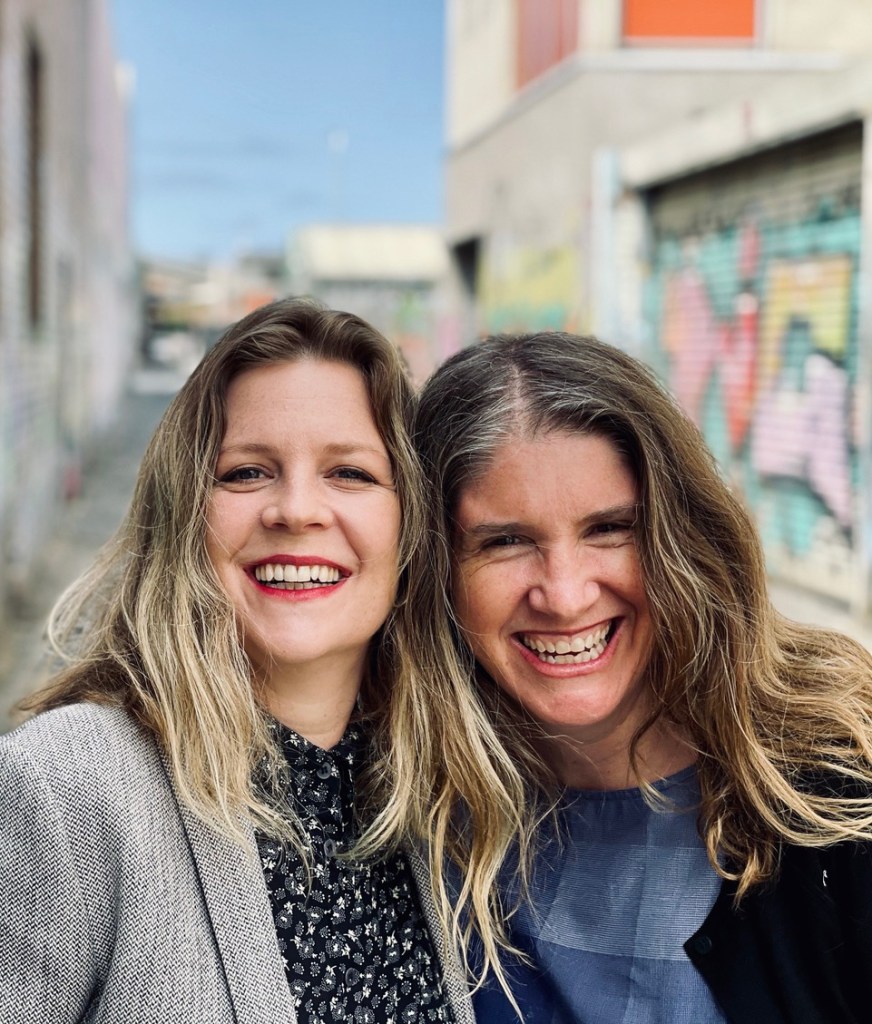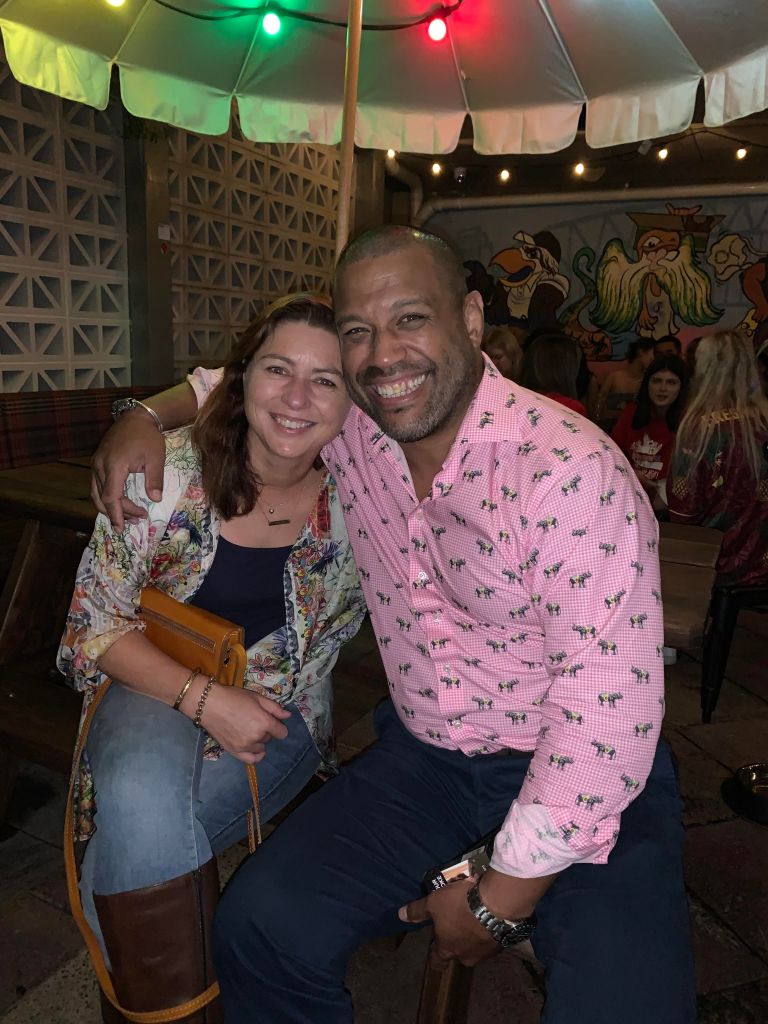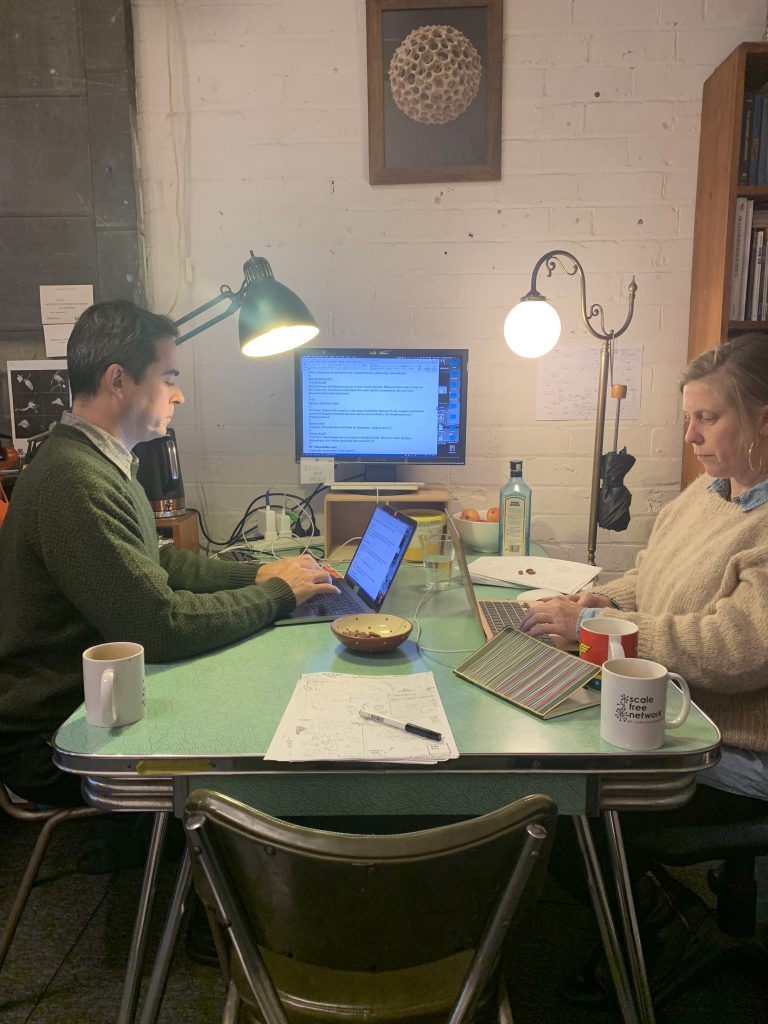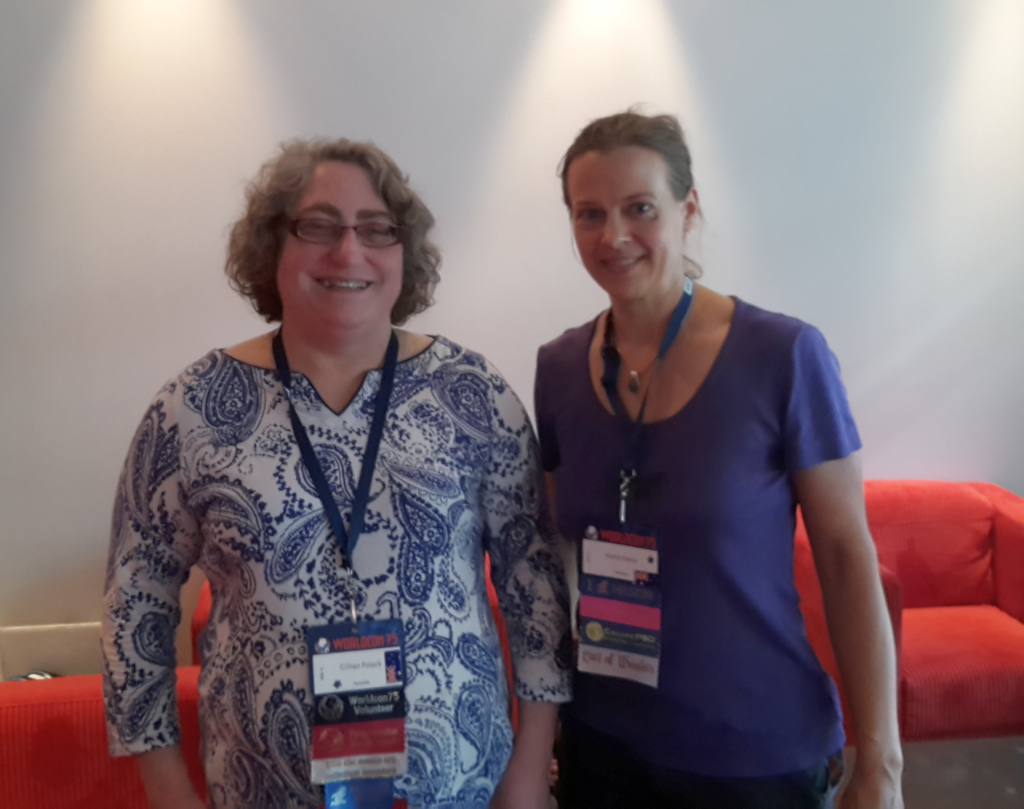Writing is such a solitary, lonely experience. You bunker down over your messy manuscript or tap away on the screen whenever you can steal moments away from life’s pressing demands, but what if you could share the load with a fellow scribe or even multiple writers? Maybe agonising over the narrative together could make the process less frustrating and more productive. ArtsHub reached out to several authors (of a young adult [YA] novel, a memoir, a non-fiction and a graphic textbook, respectively) to see what their writerly partnerships were like.
Co-writing a YA novel
Nova Weetman and Emily Gale’s Young Adult book, Outlaw Girls, is a historical time-slip novel for readers aged 10-14 years. ‘It’s set in the High Country and it’s about a friendship between two spirited horse-riding teenage girls who live 140 years apart,’ says Weetman. It’s the second time the pair have co-written together, their first effort produced Elsewhere Girls.
As the books are a blend of historical research and fiction, the writers spent several months visiting the sites of their real characters. ‘For Outlaw Girls, there was a huge amount of research involved because [one] character is Ned Kelly’s sister, and it’s important to get the details right,’ Weetman tells ArtsHub. ‘Because we were writing two characters with alternating points of view, we had to develop our own characters and voices as well as plotting the entire book in a partnership.

‘We each wrote one of the characters and then sent the chapters back and forth like a series of letters that we each responded to. Our first round of edits were also very organic and collaborative, and we were very honest about each other’s chapters as we went. We were focused on our different parts, but we also needed to grasp the full story arc and make sure we were both happy with the entire book.’
Co-writing a memoir
So Far, So Good is the memoir of Torres Strait Islander actor, producer and board member Aaron Fa’Aoso, co-created with Michelle Scott Tucker, who tells ArtsHub, ‘It’s a multilayered story – as much about the joys of Torres Strait culture as it about the darkness of colonialism, racism, grief, violence and trauma. Controversially, it also discusses how Aaron experienced domestic abuse as a child, and then subsequently as an adult perpetrator. He candidly discusses his horror, shame and regret and takes full responsibility for it all.’
It was literary agent Jacinta di Mase who first pitched the idea to Fa’Aoso – who was reluctant, given his emotional investment in the subject matter, but he eventually agreed to a co-writing venture. Di Mase brokered the partnership.

Tucker drove the process and the narrative; Fa’Aoso supplied the content. ‘Very early on we agreed our parameters: everything that we discussed would remain in strict confidence, as would anything that ended up in the first draft. The draft would not be circulated (to Aaron’s family, and our editor at Pantera) until Aaron was comfortable with it. Essentially, Aaron had right of veto over every word. Although we also agreed that his mother could read and revise the draft too, which she did, although [she made] no major changes,’ says Tucker.
As Fa’Aoso lives in Cairns and Tucker in regional Victoria, most of the book was written during COVID times. ‘We conducted about 60 to 80 hours of Zoom interviews, and spent probably the same amount of time on the phone. Aaron discussed his life, and then both of us would discuss/workshop how we were going to present that information. Then Michelle would write it up.’
Co-writing a historical non-fiction
Gillian Polack and Katrin Kania’s book, The Middle Ages Unlocked, was written for a general audience and explores Medieval life in England. Kania describes it as, ‘A travel guide to a different country, explaining the aspects of their culture – from politics to food, medicine and what people do for leisure. Our aim was to give our readers a solid overview and enough basic knowledge to let them continue exploring the individual topics for themselves.’
As the amount of information needed for the project was vast, it made sense to pool their specific knowledge bases. Polack explains, ‘I’m an ethnohistorian and Katrin is an archaeologist. Our combined understanding of the Middle Ages was considerably more than the sum of its parts. This is, to me, ideal for co-writing: creating something more than either of us could do alone.
‘From my end, I remember us beginning by identifying our strengths. We set out the subjects and their order, and returned to this over and over again. I think the order of chapters was both our nightmare and our golden thread: every time we reconsidered it, we discovered critical elements that we might have neglected.
‘I’m a novelist and an historian, which means writing and ethnohistory are my strengths. I would analyse sentences and chapter structures and make sure they held together. Also I’d make long lists of how to describe life in the Middle Ages and try to fit different concepts together in a way that would make them understandable to modern readers.
‘Katrin is an archaeologist and her organisational skills are extraordinary. This is why she held the draft status and prodded us to improve each section. From my end, her capacity to work patiently through all issues made far more of a difference than my ability to write easily on most subjects. Our different disciplines led to some really interesting discussions about language. Sometimes Katrin’s argument won, sometimes mine did … and the jury is still out on how we use the word “settlements”.’
Co-writing a graphic textbook
It’s hard enough working with just one co-writer, but what about multiples? Ailsa Wild, Gregory Crocetti, and Briony Barr are working on their sixth book together. ‘The latest book, Follow Your Gut – out in September this year from Scribe – is a comic that ate a biology textbook’ says Wild. ‘It’s the story of a timid Bifidobacterium named Biffy, who is forced to leave their family and become part of a new community, in the gut of a newborn human baby. It’s an epic adventure set over the first three years of a new human life, from the point of view of the microbes.’
‘We began working together because Gregory is a microbiologist and he wanted to communicate his passion about microbes through story’ Wild tells ArtsHub. ‘I was looking for writing projects and said yes even though I had no science training. So, I was the narrative person, Gregory was the scientist and Briony came in as the art director as we realised we needed her. None of us could possibly have made the book alone. Also, I think Gregory, as a published research scientist, was familiar with the idea of co-writing papers, so co-writing narrative was just a step sideways for him. After the first book, we just kept going.’
But just when you think three writers was plenty enough, Wild clarifies that for Follow Your Gut there were actually five collaborators: Lisa Stinson, scientist of the human milk microbiome; Gregory a microbial ecologist; Briony, the art director, Ben Hutchings the illustrator, and herself, the lead author.

‘We started the process by meeting as a group to get our heads around the science. We also tossed around narrative ideas and workshopped the potential characters of different microbes. Then I wrote scripts for chapter drafts and sent them to everyone.
‘People weighed in with info from their specialities. Ben has written and illustrated comics for years, so he was the expert in the medium. Gregory and Lisa ensured the events in the story were biologically and chemically correct (and kept adding sciency curve-balls). Briony was big picture, thinking about the philosophy of the work and the consistency of the story world, as well as having a real sense of practicality and how the design might work.
‘But we also all stepped out of our roles at different points. I couldn’t say that any single sentence in the story was just written by me. Gregory wrote an appendix, which is almost as long as the narrative, explaining the science behind the story – and again we all played a part in that process.’
The challenges and joys of co-authorship
For Weetman, the benefits of co-writing surpassed any problems. ‘We have to find the time to focus on co-writing between our solo projects, so sometimes matching our schedules can be challenging. But it’s been a really joyful process, an extension of an already very strong and developed friendship. We have very different ways of working, but actually co-writing has mostly benefited from that. Sometimes writing is a very lonely process, and when you are writing with a friend and both invested in the book, then it becomes something much less onerous and more pleasurable in many ways. You also have a companion for public speaking, events and reviews!’
So enjoyable has their collaboration been that Weetman and Gale are considering partnering up again for a third book.
Tucker too enjoyed her co-steering and co-writing experience. ‘We were always in strong agreement about what we were trying to achieve (raising awareness of Torres Strait culture and people) and the importance of the project,’ she says. ‘But I probably underestimated the intense emotional toll of this project on Aaron. He found opening up those old wounds to be absolutely brutal, in an emotional sense. Both of us were brought to tears at different times.
‘As a result of all that emotional turmoil, Aaron found it very difficult to read the early drafts – he put it off for months! That was hard on me as I was very conscious of the looming deadlines and our contractual obligations. But we got there in the end, and on time, with a draft manuscript that we really were very proud of.’
Kania and Polack live on the opposite side of the world and initially there was doubt whether the long-distance writing relationship would be sustainable, but the time difference ended up working in their favour. Says Polack, ‘Fortunately I was the “work on it in the morning” person and Gillian would sit down during her evening and night, and that lined up perfectly. It was wonderful to wake up to some work having magically happened over night! And for our chat meetings, we still had enough of an overlap in our preferred work times to get together for a few hours and get things discussed and done.

‘The biggest challenge I remember to be on some of the wordings. We were trying to write as clearly as possible, but in some cases there’s just not enough knowledge about a topic or aspect to state “this is how it was” (apart from the fact that there was always a lot of variety, much like in life today). So we tweaked and fine-tuned and sometimes one of us didn’t quite get what the problem was, to the annoyance of the other party, and much explaining had to happen. However, these things also served to make us aware of possible issues for the readers, so they were a good thing in the end.
‘We did solve all of these problems eventually, to the contentment of both of us, but I do remember some quite heated discussions over chat! I also found it quite interesting to see how our individual writer’s voices sort of melded over time.’
For Wild, collaboration is time-consuming a process but with satisfying final results, ‘We met over and over again, often for hours. Sometimes it felt gruelling and other times our meetings dissolved into exhausted hilarity. When we disagreed about things, we had to just keep on talking. If you have five experts in a room, each championing their area of specialty, it can be a wonderful way to create something really rich and layered. Something a single one of us simply couldn’t have done.’
Tips for those thinking of co-authorship?
Weetman suggests authors need to choose wisely. ‘You need to feel comfortable being vulnerable with each other. You need to be honest with each other,’ she says. ‘You need to edit each other and accept that there will be compromises, because you are different people and different writers. Patience is important, because you will probably work at different speeds. And it’s really important that you feel equal in the process – you may have different strengths, but your voices both need to be respected.’
For Tucker it’s all about sustaining communication between the parties: ‘Keep talking to one another, about the content and about the process. Aaron and I usually spoke or wrote or texted one another at least several times a week, in addition to the Zoom interviews. All questions were acceptable (there were no stupid questions).
She also recommends playing to your strengths in this joint project. ‘Stay in your lane. I brought my writing expertise, Aaron was the subject matter expert. He didn’t tell me how to construct a sentence and I drew heavily on his cultural expertise and authority.’
Polack suggests co-authors understand their ambitions for the project before beginning. ‘Know that learning how you write and what you take for granted in your own writing will play a big part in a good outcome.’
Read: Literary judging: take a look behind the scenes
Kania has several tips to keep co-writing as amicable a process as possible. ‘Just like in a romantic relationship, it starts out with a honeymoon phase where everyone is totally motivated and things will happen almost on their own,’ she says, ‘but transforming this into a solid, steady working relationship for a longer time will take work and commitment, and the will to make it work, from all parties.
‘If co-authorship works well, it will be an utterly wonderful experience, and incredibly satisfying, but don’t expect it to run smoothly all the time, even in the best of cases. Be prepared to make compromises and always treat your writing partner with respect. You are in this together.
‘On the technical side, make sure you have a clear system for handling your files, make back-ups religiously, and have someone designated to keep track of what are the most current files, so nothing untoward creeps in and nothing gets lost. (I earned the title “Master Hamster” for doing this in our cooperation.)
‘Set deadlines for working on and finishing things (sensible ones). Be clear on who takes on what task, and agree on a time for the next meeting as you end the current one. Keeping the momentum is very important! There will be breaks as life happens or people go on vacation, but make sure you have a fixed date for a meeting when everyone gets back on board, so you can take up things again, and get them rolling.’
Wild suggests planning a long lead time for the project to take shape, ‘In the early stages, give things a try even if you think they won’t work. Trust your co-creator/s. But also, choose to collaborate with people you feel comfortable saying no to.’
And the final bit of advice for any co-writing partnership? Both Tucker and Polack propose a writing arrangement that is as equal as possible: ‘Leave your ego at the door. Unless it’s a true collaboration, it’s just not going to work.’





